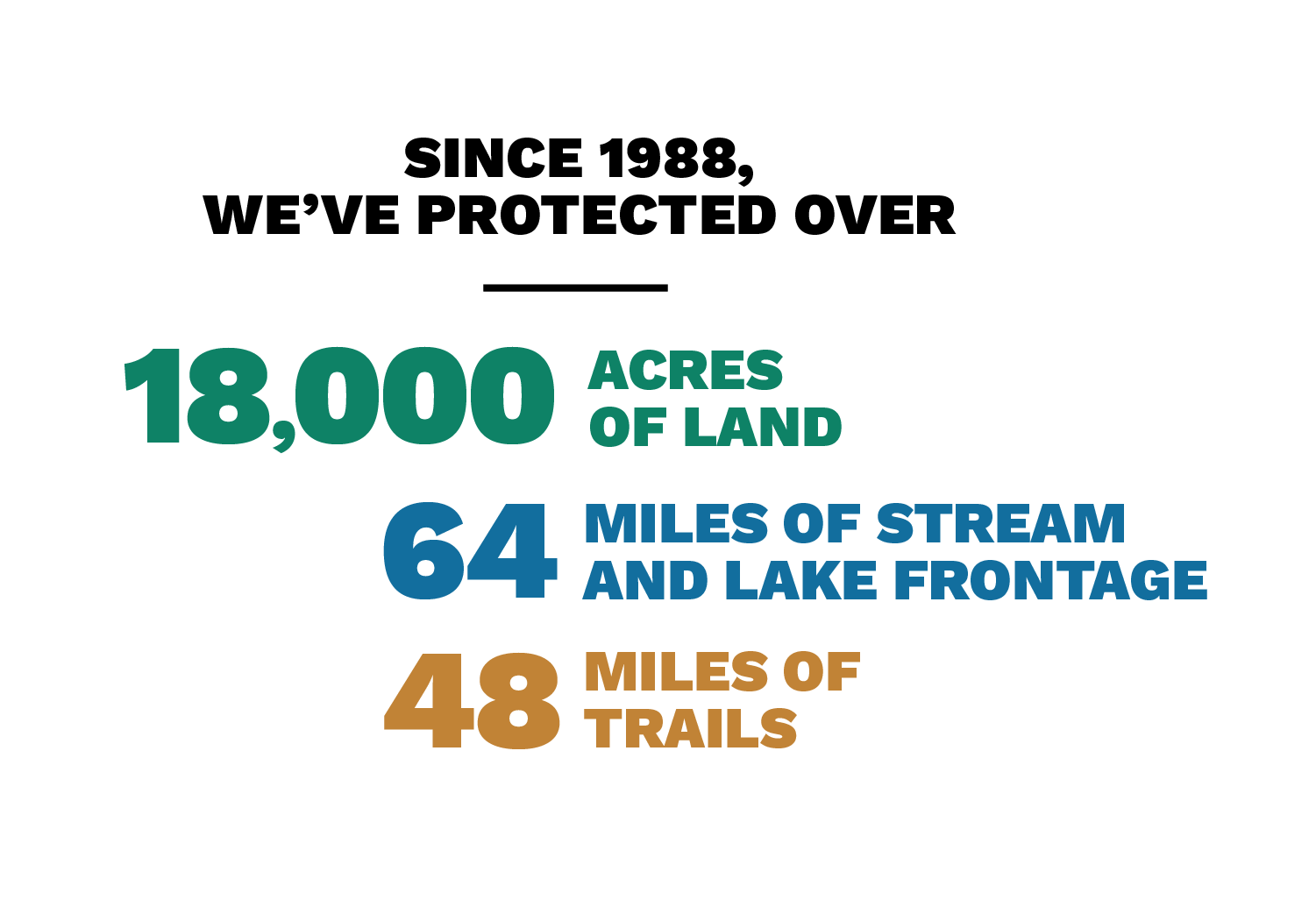Millers Donate Conservation Easements on 120 Acres to Protect Lake Leelanau Watershed
From our Spring 2005 Newsletter
When Bob and Eleanor Miller bought their 160 acres in Centerville Township back in 1977, there were only a handful of people living year round in that part of the county. Bob, a psychiatrist, had just taken a job at the Traverse City State Hospital. Eleanor, who has a Masters in social work, had strong ties to the area; her family had carried on a tradition of summering in Leland that had begun with her ancestors in the early 1900s.
Although they considered themselves “city people,” the Millers fell in love with the land and the idea of living just up the hill from South Lake Leelanau. They hoped for children eventually and viewed their 160 acres as a “quiet, safe place where kids could just be immersed in nature,” says Eleanor. The weathered barn on the property was also a selling point: Eleanor had grown up with horses and wanted them in her life again.
They lived in a circa 1900s farmhouse on the property for eight years. A woodstove sufficed for heat; the house had no insulation. In time, they had a son, then a daughter, and built a simple, energy-efficient ranch house up a slight rise behind the farmhouse, but in a valley where it is protected from the winds. Eleanor got her horses, (there are now 11 in the barn) and began to volunteer as a 4-H leader. The old logging trails on the property made for good riding and wildflower hikes. Today, 4-H kids bunk in the old farmhouse for the week-long summer riding camps Eleanor hosts.
Among the land’s other features: spectacular views of Lake Leelanau provided by many vantage points on their property, along with a mature and ecologically diverse northern beech-maple hardwood forest. A tributary of Rice Creek, which drains into South Lake Leelanau, runs through the Millers’ northwestern corner. The creek provides valuable habitat for many species of plants and animals. “All of these features combined make it a significant contributor to the health of the Lake Leelanau Watershed,” says Matt Heiman, Conservancy Land Protection Specialist.
The Millers’ part of the county was so unpopulated when they first moved here that they weren’t even on the school bus route. That would soon change. “All of a sudden Rosinski Road got developed and paved,” says Eleanor. “Houses started going up and we saw how quickly and easily land can be divided and developed.”
They knew from the start that they wanted most of their land to remain undisturbed forever. Eleanor remembers receiving a packet of information in the mail from the Conservancy and put it on a stack of intended reading material on her nightstand. But she was so busy then—that was around the time that the State Hospital closed and Bob began commuting to Detroit—something he would do for the next 10 years.
The decision they made to spend the week apart as a family “reflected just how tied we are to this land,” says Bob. The arrangement was taxing, but also had surprising benefits. “Coming home every weekend felt like a big vacation,” says Bob. “We talked daily and made it a point to really concentrate on those conversations, something you sometimes don’t do when you areliving in the same house.” Somehow, he managed to get home for important events, and laughs when recalling having to fly in and out one night for a school concert. “That was one expensive concert,” he says.
As time passed and they saw more land around them developed, the Millers knew they wanted to do something that would permanently protect a large portion of their land. In 2001 they donated a conservation easement on 60 acres with the intent of donating a second 60-acre easement later, “so we could take the tax benefits in phases,” says Bob.
Though not the impetus for protecting their land, the tax benefits (see box) that come with giving up development rights were an added plus, says Bob. He adds that they are leaving 40 acres unrestricted to keep their options open.
“It was a no-brainer when the Conservancy emerged, and we realized we could have someone advocate for our wishes,” says Bob. “When you are younger you think you are going to be here forever. But we’re not, and we like that the Conservancy can provide a structure to protect the land long after we’re gone. It became the vehicle for us to meet our objectives.”
Bob says they “appreciate that financially we are in a position to donate an easement. Others may not be in a position but that doesn’t mean that they don’t care or love the land. But they should be aware of all their options.”
While the Conservancy has traditionally relied on landowner donations of conservation easements, we are uniquely positioned for the next two years to pay landowners most of the value of the development rights that are extinguished by a conservation easement in the Lake Leelanau watershed. Funds are available through a Clean Michigan Initiative (CMI) Grant the Conservancy received in 2003 to help protect wetlands and ground water recharge areas in the Lake Leelanau Watershed.
The Conservancy, with the help of the Lake Leelanau Lake Association, is currently fundraising with a goal of raising $1.5 million to protect the Watershed through the purchase of conservation easements
Since receiving the CMI grant the Conservancy has found that many landowners were thrilled to learn they could be compensated for permanently foregoing the development of the land—land which they wanted to remain wild. Land that was being held for hunting, recreation, timber production or just a buffer providing solitude and privacy is often a great fit for the purchase of a conservation easement.
In many cases protection of sensitive areas is perfectly compatible with traditional uses. Conservation easements are crafted to meet the landowner’s goals and achieve a public purpose, such as watershed protection.
The Millers say they would be happy to talk to any landowner that wants to ask questions of someone who has done a conservation easement. “Our experience over the 10 years we have worked with the Conservancy is that they have been really flexible,” says Bob, who serves on our Lake Leelanau Watershed Initiative steering committee. “The easement allows you to use the land in the way you want. What I’d like to see is a concerted effort of neighbors working together to protect large blocks of land. If we don’t, this will all end up subdivided into a sea of houses.”



